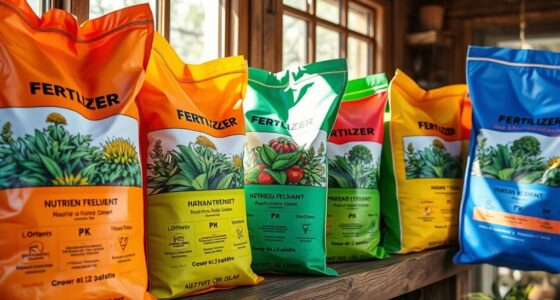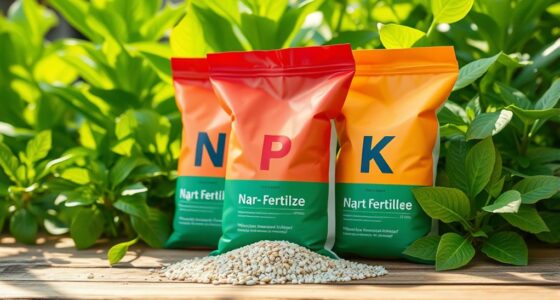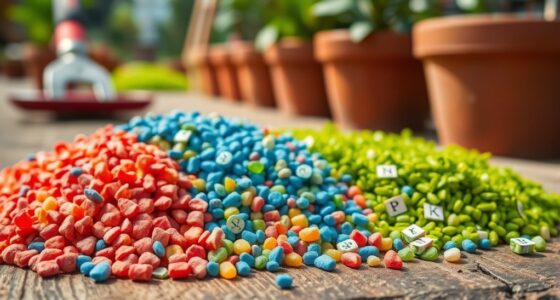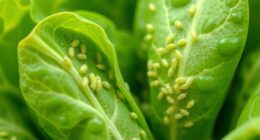Understanding N-P-K ratios helps you choose fertilizers that match your plants’ needs. N is for leafy growth, P supports roots and blooms, and K boosts overall resilience. Soil testing reveals your garden’s current nutrient levels and guides you on what to add. Using the right balance prevents deficiencies or excesses, promoting healthy plants. Keep these basics in mind to guarantee your garden thrives—there’s more detail ahead to improve your fertilization skills.
Key Takeaways
- N-P-K represents the essential nutrients nitrogen, phosphorus, and potassium, crucial for plant growth and development.
- Understanding your plants’ specific needs helps select the right N-P-K ratio for optimal health.
- Soil testing reveals current nutrient levels, guiding appropriate fertilizer application and preventing deficiencies.
- Different plants require tailored N-P-K ratios; leafy greens prefer higher nitrogen, while flowering plants need more phosphorus.
- Proper fertilizer application methods and timing enhance nutrient uptake and promote healthy, productive plants.
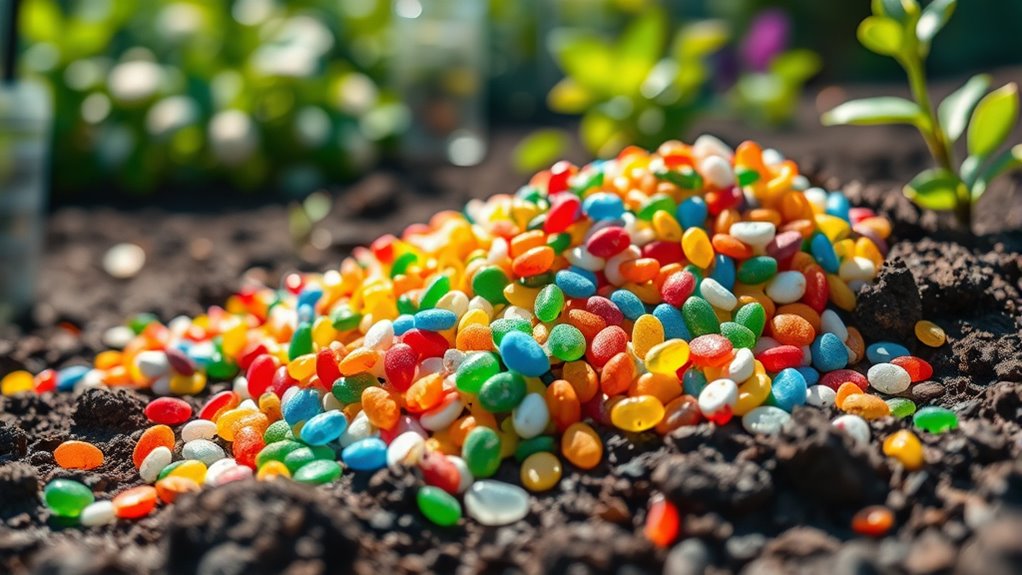
Have you ever wondered how plants grow so lush and healthy? The secret lies in understanding what they need and providing it in the right amounts. A key step is soil testing, which helps you determine the current nutrient levels and pH balance of your soil. Instead of guessing, testing your soil allows you to make informed decisions about fertilization, preventing over-application or deficiencies. Many gardeners overlook this step, but it’s essential to optimize plant health and avoid wasting money on unnecessary fertilizers. Once you know your soil’s condition, you can choose the appropriate nutrients to boost growth.
Organic fertilizers are a popular choice among savvy gardeners because they improve soil fertility naturally. These fertilizers are made from plant or animal materials, such as compost, manure, or bone meal, and release nutrients slowly over time. Unlike chemical fertilizers, organic options enhance soil structure, increase microbial activity, and support long-term plant health. Applying organic fertilizers isn’t just about feeding your plants; it’s also about nurturing the soil ecosystem that sustains them. It’s a sustainable approach that helps maintain balance and reduces the risk of nutrient runoff, which can harm the environment.
Understanding the N-P-K ratio is fundamental to effective fertilization. N-P-K stands for nitrogen, phosphorus, and potassium—three primary nutrients plants need in varying amounts. Nitrogen promotes leafy, vigorous growth; phosphorus encourages strong roots and flowering; potassium improves overall plant resilience and fruit quality. When selecting a fertilizer, check the label for these ratios to match your plants’ specific needs. For example, leafy vegetables may require higher nitrogen, while flowering plants benefit from more potassium and phosphorus. Using a balanced fertilizer without considering these ratios can lead to nutrient imbalances, which might stunt growth or cause disease.
Informed fertilization starts with soil testing and understanding your plants’ requirements. Organic fertilizers can be tailored to meet these needs, providing nutrients gradually while enriching the soil. Remember, no single fertilizer fits all situations. Regular testing and observation help you adjust your approach, ensuring your garden stays healthy and productive. Additionally, choosing fertilizers that are compatible with different application methods can make your fertilization routine more effective and efficient. By embracing these practices, you set the foundation for lush, thriving plants that flourish season after season. Whether you’re growing vegetables, flowers, or trees, knowing what your soil and plants need is the key to success.
Frequently Asked Questions
How Do I Choose the Right Fertilizer for My Specific Plant?
To choose the right fertilizer for your plant, start by testing your soil to identify any nutrient deficiencies. This helps you select a fertilizer with the appropriate N-P-K ratio and other essential nutrients. Pay attention to your plant’s specific needs—some require more nitrogen for leafy growth, while others need phosphorus for flowering. Regular soil testing guarantees you provide targeted nutrients, promoting healthy, thriving plants.
Can Over-Fertilizing Harm My Plants?
Imagine your plants as delicate dancers on a tightrope, too much fertilizer can tip the balance. Over-fertilizing can cause fertilizer toxicity, damaging roots and leaves. It can also alter soil pH, making nutrients harder to absorb. You might see yellowing or stunted growth. To avoid harm, always follow recommended application rates and monitor soil conditions, ensuring your plants stay healthy and vibrant without the risk of overfeeding.
How Often Should I Fertilize Indoor Versus Outdoor Plants?
You should fertilize indoor plants every 4-6 weeks and outdoor plants every 2-4 weeks, depending on their growth and season. Adjust based on watering frequency and soil preparation; well-prepared soil helps nutrients absorb better. Indoor plants often need less frequent fertilization because they’re less exposed to weather changes, while outdoor plants may need more frequent feeding due to environmental stresses. Always monitor your plants for signs of nutrient deficiencies.
Are Organic Fertilizers as Effective as Synthetic Ones?
You might wonder if organic versus synthetic fertilizers are equally effective. Organic options release nutrients slowly and improve soil health, while synthetic fertilizers offer quick nutrient boosts. When comparing nutrient content, synthetic fertilizers usually have higher concentrations, making them faster acting. However, organic fertilizers promote long-term plant health and sustainability. The best choice depends on your plants’ needs and your gardening goals, but both can be effective when used correctly.
What Signs Indicate My Plants Need More Nutrients?
Ever wonder if your plants are craving more nutrients? Look for signs like leaf discoloration or stunted growth—these clues hint they’re not getting enough to thrive. When leaves turn yellow or pale, or if your plants stop growing taller or producing new leaves, it’s time to step up your fertilizing game. Keep an eye out; healthy plants tell you what they need before it’s too late.
Conclusion
Now that you understand the dance of N-P-K, you hold the key to revealing your plants’ true potential. Think of fertilizers as the secret recipe for a lush garden—balance, patience, and knowing what your plants crave. When you nurture with care, your garden blooms like a symphony, each plant singing in harmony. With this knowledge, you’re not just growing plants; you’re cultivating a vibrant, living masterpiece.


